Brandon Norick
Nemotron-H: A Family of Accurate and Efficient Hybrid Mamba-Transformer Models
Apr 10, 2025Abstract:As inference-time scaling becomes critical for enhanced reasoning capabilities, it is increasingly becoming important to build models that are efficient to infer. We introduce Nemotron-H, a family of 8B and 56B/47B hybrid Mamba-Transformer models designed to reduce inference cost for a given accuracy level. To achieve this goal, we replace the majority of self-attention layers in the common Transformer model architecture with Mamba layers that perform constant computation and require constant memory per generated token. We show that Nemotron-H models offer either better or on-par accuracy compared to other similarly-sized state-of-the-art open-sourced Transformer models (e.g., Qwen-2.5-7B/72B and Llama-3.1-8B/70B), while being up to 3$\times$ faster at inference. To further increase inference speed and reduce the memory required at inference time, we created Nemotron-H-47B-Base from the 56B model using a new compression via pruning and distillation technique called MiniPuzzle. Nemotron-H-47B-Base achieves similar accuracy to the 56B model, but is 20% faster to infer. In addition, we introduce an FP8-based training recipe and show that it can achieve on par results with BF16-based training. This recipe is used to train the 56B model. All Nemotron-H models will be released, with support in Hugging Face, NeMo, and Megatron-LM.
Nemotron-CC: Transforming Common Crawl into a Refined Long-Horizon Pretraining Dataset
Dec 03, 2024Abstract:Recent English Common Crawl datasets like FineWeb-Edu and DCLM achieved significant benchmark gains via aggressive model-based filtering, but at the cost of removing 90% of data. This limits their suitability for long token horizon training, such as 15T tokens for Llama 3.1. In this paper, we show how to achieve better trade-offs between accuracy and data quantity by a combination of classifier ensembling, synthetic data rephrasing, and reduced reliance on heuristic filters. When training 8B parameter models for 1T tokens, using a high-quality subset of our data improves MMLU by 5.6 over DCLM, demonstrating the efficacy of our methods for boosting accuracies over a relatively short token horizon. Furthermore, our full 6.3T token dataset matches DCLM on MMLU, but contains four times more unique real tokens than DCLM. This unlocks state-of-the-art training over a long token horizon: an 8B parameter model trained for 15T tokens, of which 7.2T came from our dataset, is better than the Llama 3.1 8B model: +5 on MMLU, +3.1 on ARC-Challenge, and +0.5 on average across ten diverse tasks. The dataset is available at https://data.commoncrawl.org/contrib/Nemotron/Nemotron-CC/index.html
An Empirical Study of Mamba-based Language Models
Jun 12, 2024



Abstract:Selective state-space models (SSMs) like Mamba overcome some of the shortcomings of Transformers, such as quadratic computational complexity with sequence length and large inference-time memory requirements from the key-value cache. Moreover, recent studies have shown that SSMs can match or exceed the language modeling capabilities of Transformers, making them an attractive alternative. In a controlled setting (e.g., same data), however, studies so far have only presented small scale experiments comparing SSMs to Transformers. To understand the strengths and weaknesses of these architectures at larger scales, we present a direct comparison between 8B-parameter Mamba, Mamba-2, and Transformer models trained on the same datasets of up to 3.5T tokens. We also compare these models to a hybrid architecture consisting of 43% Mamba-2, 7% attention, and 50% MLP layers (Mamba-2-Hybrid). Using a diverse set of tasks, we answer the question of whether Mamba models can match Transformers at larger training budgets. Our results show that while pure SSMs match or exceed Transformers on many tasks, they lag behind Transformers on tasks which require strong copying or in-context learning abilities (e.g., 5-shot MMLU, Phonebook) or long-context reasoning. In contrast, we find that the 8B Mamba-2-Hybrid exceeds the 8B Transformer on all 12 standard tasks we evaluated (+2.65 points on average) and is predicted to be up to 8x faster when generating tokens at inference time. To validate long-context capabilities, we provide additional experiments evaluating variants of the Mamba-2-Hybrid and Transformer extended to support 16K, 32K, and 128K sequences. On an additional 23 long-context tasks, the hybrid model continues to closely match or exceed the Transformer on average. To enable further study, we release the checkpoints as well as the code used to train our models as part of NVIDIA's Megatron-LM project.
Phi-3 Technical Report: A Highly Capable Language Model Locally on Your Phone
Apr 23, 2024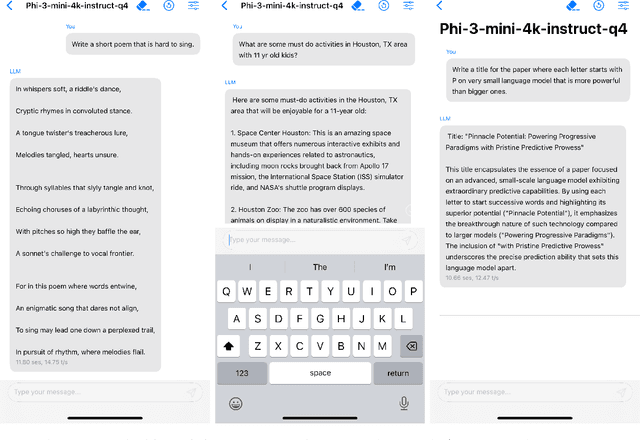

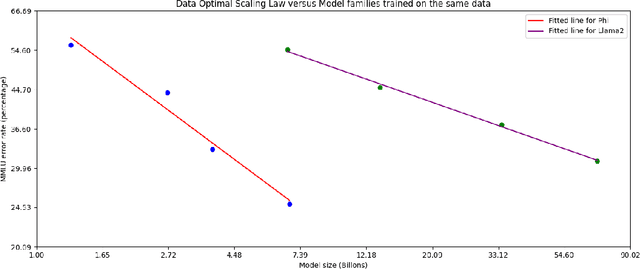
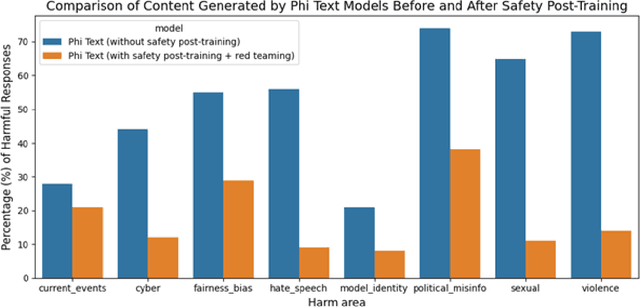
Abstract:We introduce phi-3-mini, a 3.8 billion parameter language model trained on 3.3 trillion tokens, whose overall performance, as measured by both academic benchmarks and internal testing, rivals that of models such as Mixtral 8x7B and GPT-3.5 (e.g., phi-3-mini achieves 69% on MMLU and 8.38 on MT-bench), despite being small enough to be deployed on a phone. The innovation lies entirely in our dataset for training, a scaled-up version of the one used for phi-2, composed of heavily filtered web data and synthetic data. The model is also further aligned for robustness, safety, and chat format. We also provide some initial parameter-scaling results with a 7B and 14B models trained for 4.8T tokens, called phi-3-small and phi-3-medium, both significantly more capable than phi-3-mini (e.g., respectively 75% and 78% on MMLU, and 8.7 and 8.9 on MT-bench).
Using DeepSpeed and Megatron to Train Megatron-Turing NLG 530B, A Large-Scale Generative Language Model
Feb 04, 2022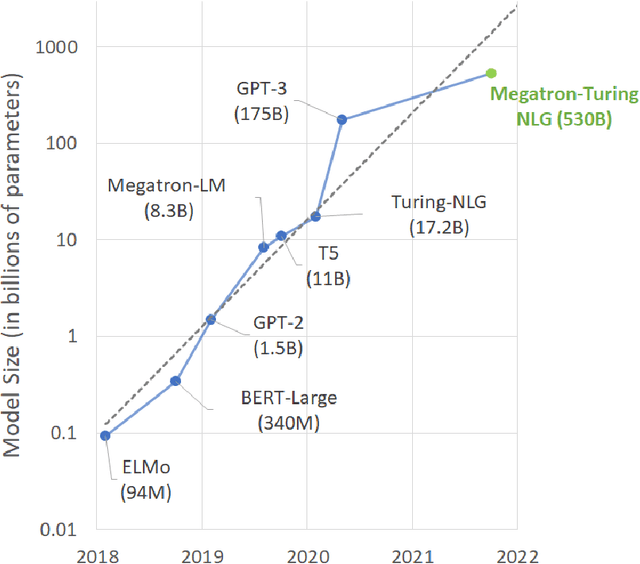
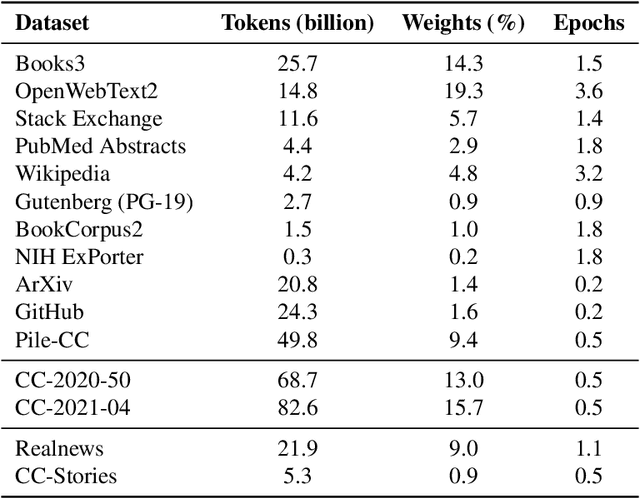
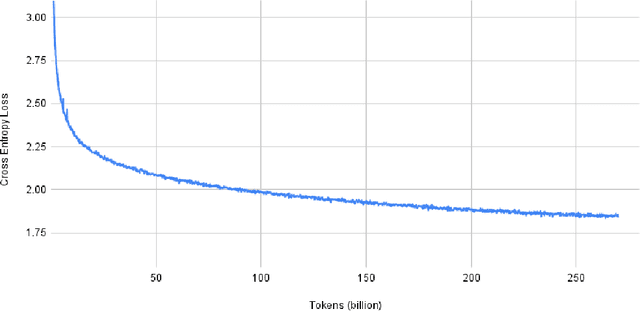
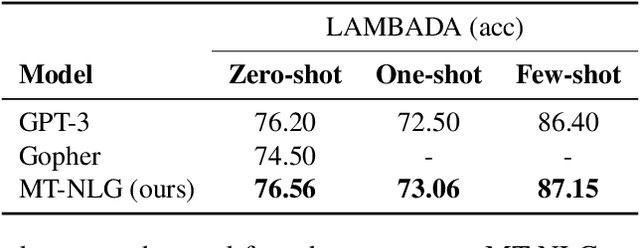
Abstract:Pretrained general-purpose language models can achieve state-of-the-art accuracies in various natural language processing domains by adapting to downstream tasks via zero-shot, few-shot and fine-tuning techniques. Because of their success, the size of these models has increased rapidly, requiring high-performance hardware, software, and algorithmic techniques to enable training such large models. As the result of a joint effort between Microsoft and NVIDIA, we present details on the training of the largest monolithic transformer based language model, Megatron-Turing NLG 530B (MT-NLG), with 530 billion parameters. In this paper, we first focus on the infrastructure as well as the 3D parallelism methodology used to train this model using DeepSpeed and Megatron. Next, we detail the training process, the design of our training corpus, and our data curation techniques, which we believe is a key ingredient to the success of the model. Finally, we discuss various evaluation results, as well as other interesting observations and new properties exhibited by MT-NLG. We demonstrate that MT-NLG achieves superior zero-, one-, and few-shot learning accuracies on several NLP benchmarks and establishes new state-of-the-art results. We believe that our contributions will help further the development of large-scale training infrastructures, large-scale language models, and natural language generations.
 Add to Chrome
Add to Chrome Add to Firefox
Add to Firefox Add to Edge
Add to Edge